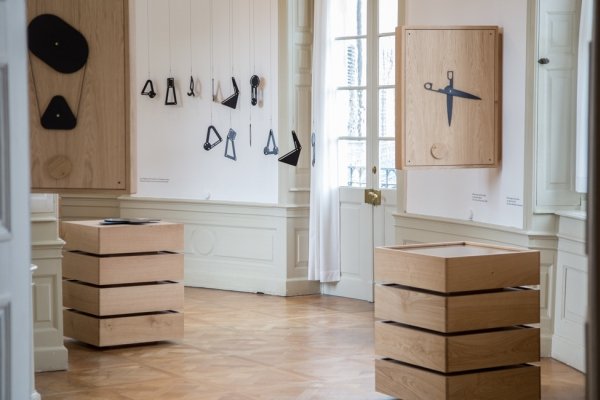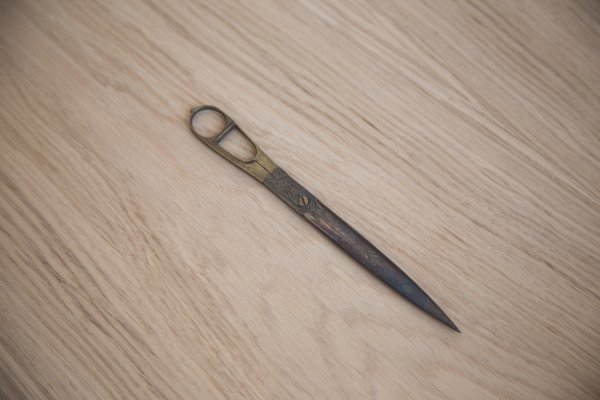Back in February the participants of the exhibition "Trading Places. Designers meet the collection" at the Kunstgewerbemuseum Dresden spent two days trawling through the museum's depots looking for objects with which to work.
During the tour Daphna Isaacs and Laurens Manders, aka Eindhoven based studio Daphna Laurens, were shown inside a drawer. Walked on. Stopped. Walked back. Looked inside the drawer again and asked Herr Knorr, Head of metal, glass and ceramics at the Kunstgewerbemuseum, about one particular object.
"At first we thought that it was some sort of letter opener", remembers Daphna Isaacs, "and then he took it in is hand and slowly opened it and we were like "Wow!!!""
That pair of 18th/19th century Persian scissors, for that is what the believed letter opener turned out to be, now forms the centre piece of the installation "At first glance", Daphna Laurens' contribution to Trading Places.
Or better put the pair of scissors and Daphna Laurens' reaction, "We wanted to share with the museum visitors the experience we'd had of experiencing the scissors for the first time", explains Laurens Manders, "the experience of observing one shape transforming into another and of where that can lead, what that can stimulate. Consequently as we were considering how best to design an installation about the scissors it was very clear to us that it had to be dynamic."
The result is an interactive installation which invites visitors to play with shapes, observe changing shapes and generally lose oneself for a few minutes in the meditative properties of metamorphosis, transfiguration and modulation. In addition to a replica of the original scissors which visitors can open and close, At first glance also features abstract 2D forms which can be altered through the use of cogs and pulleys and a series of anodised aluminium geometric shapes which visitors can take in their hands and play with: a physical process, and indeed emotional process, very reminiscent of handling worry beads or baoding balls to help pass time and focus concentration.
Or as Laurens eloquently describes it, "Its a bit like cycling or walking. At some point your mind gets freed, your thoughts liberated, and you can think clearer. Playing with our installation is a lot like that. And hopefully visitors can then view the rest of the museum's exhibits with a little more clarity."

Delightful as At first glance is we were more than a little surprised that the pair hadn't chosen a furniture object, that being the genre we most associate with Daphna Laurens. When we spoke with Kunstgewerbemuseum Director Tulga Beyerle ahead of the exhibition opening we asked her if she had also been surprised, "No, not at all", came the instant reply. "At Vienna Design Week they were involved in a Passionswege project with Wittmann Möbelwerkstätten where they created pieces of furniture and also displayed sketches from the development phase of the project. And if you looked at their drawings you could just as easily say something was a view from above, or from the side or from the front. They play around with patterns, create these abstract forms and then ask "What is it?" and subsequently develop the 3D project from there. Which in a way is all very similar to the environment that they have created here, so no it wasn't that surprising."
In addition we must note the parallels between the hand held aluminium shapes in At first glance and the collection of clips Daphna Laurens presented as part of the Dutch Invertuals "Happy Futures" showcase during Milan 2014. The clips arising from a research project Daphna Laurens undertook exploring random, abstract shapes and which were originally only intended as being a source of inspiration for the pair. But which subsequently became a product.
One must also add that Daphna Laurens did consider a piece of furniture for their project in Dresden, but ultimately the decision for the scissors was made because "they were closer to us, to our way of working, and also because with the scissors we saw the greatest potential to make an interesting installation."

But why the decision to accept Tulga Beyerle's invitation to participate in Trading Places, it's not as if the pair aren't busy enough with other projects? What motivates a design studio to participate in such a museum based project? "We would never say no to Tulga!" replies Daphna. The serious look on her face only breaking into a wide smile after a pause just long enough to, almost, lead us to believe her. Almost.
"No, every new environment and every new project is positive", she continues, "and ultimately the challenge is always the best reason for accepting such an invitation, the opportunity to explore a new field, learn new things and test oneself in a new environment. For example we made it a little hard on ourselves here through deciding to have a dynamic installation; but then through such experiences you learn a lot about yourself and your work"
"Plus" adds Laurens, "we found the idea of helping bring a museum's depot into the public sphere very interesting. A lot of the textiles, for example, will never come out of the depot because of the problems with exposing them to light and so such an exhibition is a nice way to make visitors aware of just what exists in the dark spaces of a museum depot. Similarly the scissors were lying in a fairly anonymous drawer that probably is never opened. And so we're really happy that we found them and can share that experience"
As indeed are we.
At first glance by Daphna Laurens - in addition of course to the projects by Dechem Studio, Loris & Livia, Judith Seng and mischer’traxler - can be viewed in the exhibition Trading Places. Designers meet the collection at the Kunstgewerbemuseum, Schloss Pillnitz, Dresden until Sunday November 2nd 2014.